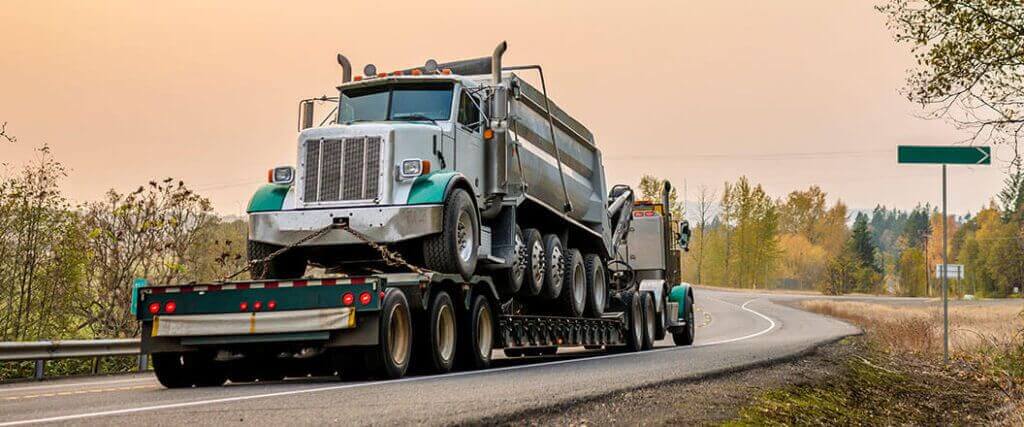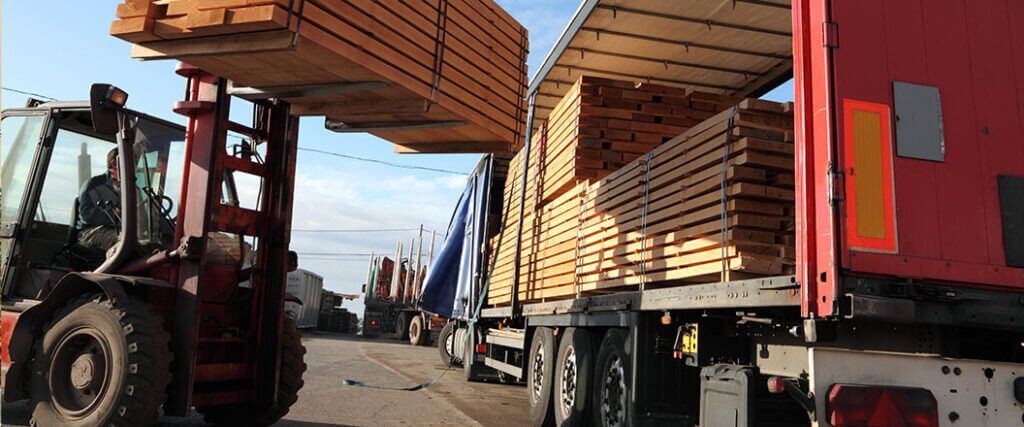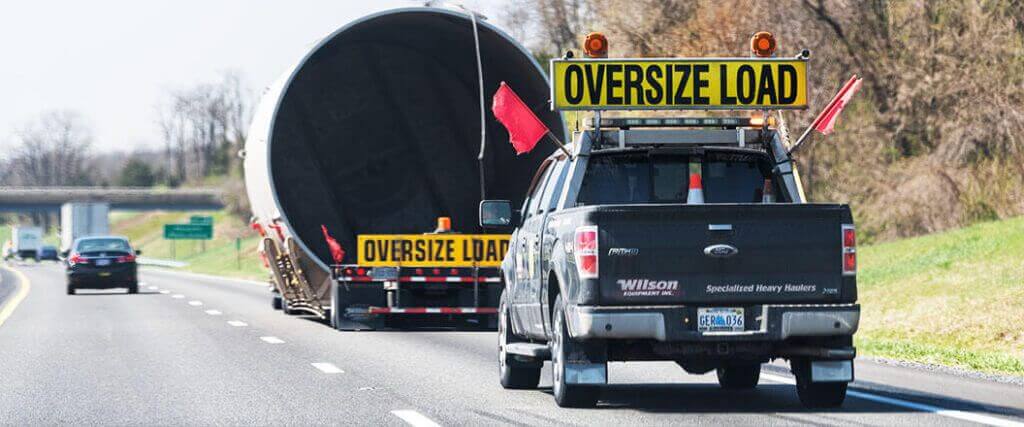Having the right trailers for hauling heavy equipment is essential when you have an oversized load. Despite their size and sturdiness, heavy equipment needs to be handled with care like any other type of freight does. With the right trailer and the right carrier, you’ll have your heavy equipment at its destination in top shape.
Trailers used for hauling heavy equipment include:
Many industries use these trailers to haul large pieces of freight that cannot fit in or on a conventional trailer or dry van.
Not only are there certain trailers for hauling heavy equipment, but there are also specialized vehicles used for the loading and unloading of oversized freight. In this article, we’ll discuss each and more.
Heavy haul equipment is a term that is sometimes used interchangeably with the terms “heavy loads” and “oversized/overweight/over-dimensional” freight. There are so many different large pieces of freight that knowing what constitutes a heavy load and what doesn’t can be difficult to discern.
That said, heavy loads aren’t determined by the type of freight being transported, but are instead determined by the dimensions and weight of the freight itself. A heavy haul load is any type of freight that has the following characteristics:
Regulations differ across state lines, but these dimensions and weight are the most common characteristics used to describe an oversize load.
One industry that commonly uses heavy loads in its operations is the construction industry.
Most construction equipment consists of vehicles and other elements that fit heavy haul criteria perfectly. AOG shipping is another type of freight service that transports large pieces of freight. Some common heavy haul equipment from the construction industry, as well as other industries, include:

Flatbeds are the most common type of trailers that are used when a heavy load has to be moved from one destination to another. Heavy haul equipment is freight so large that it can’t fit within the confines of a normal trailer.
Flatbed trailers are a great solution due to their length and open deck. Numerous flatbed trailer variations are suited for transporting certain types of heavy haul equipment.
Standard flatbed trailers are good for certain types of oversized freight. They have a length of 48 to 53 feet which leaves plenty of room for oversized loads to sit. The downside of using standard flatbeds to transport oversized freight is how high above the ground they sit.
A flatbed is usually 40 to 60 inches above the ground. Because the bed is so high, it makes transporting certain types of heavy haul equipment through low clearances impossible. Therefore, only shorter oversized freight can be hauled on a standard flatbed.

Having the right trailers for hauling heavy equipment is essential. Get a fast, personalized quote from our industry experts.
Step-deck trailers are common trailers that are used to transport oversized loads. The step deck trailer has two decks:
1. One deck being above the front axles
2. The main deck, which is lower to the ground
As far as length goes, the front deck is 11 feet, while the main deck is typically 48 feet.
Step-deck trailers are great when you need to transport tall oversized loads. The low-hanging main deck of this trailer allows a truck driver to carry a tall oversized load without the worry of being out of regulation or wondering if their freight can’t make it through certain clearances.
The main deck can carry freight with a height no taller than 10 feet while the front deck can hold freight that has a height of 8.5 feet. A step deck trailer's maximum weight limit is 48,000 pounds.
Another added benefit of using a step-deck is how easy it is for freight to be loaded and unloaded from it. Since the main deck is lower to the ground, it’s much easier for a forklift's blades to reach the freight laying on it.
Step-deck trailers are also compatible with trailer ramps, allowing a forklift to easily drive onto one for loading and unloading. Typically, step deck trailers are used to transport mid-sized heavy loads like:
Even though step deck trailers cannot carry freight above the 13ft 6in limit, they can be used to carry long pieces of freight that are over 53 feet. Most states allow freight to overhang on a 48 foot trailer like a step-deck.

Lowboys, double drop deck and removable gooseneck trailers are all very similar to one another. Therefore, we’ve lumped them together into the same category.
If a step-deck trailer doesn't reach low enough for you, then a better option is a lowboy trailer. As their name implies, lowboy trailers hang low and are only 24 inches above the ground. This allows them to carry taller loads than step deck trailers can.
The maximum load height that they can carry is around 14 feet. Unlike a step-deck trailer, lowboys are much shorter in length with the main deck maxing out at around 24 to 29.6 feet. In addition to their length and height carrying capabilities, lowboy trailers can carry 40,000 pounds of weight.
Lowboy trailers are great at carrying equipment from other industries besides construction. For example, lowboys are used for the transportation of equipment used in the oil and gas industry. This can include equipment like mining equipment and high-capacity shovels.
Agricultural equipment is also often transported with the help of a lowboy. The sturdiness and low-hanging main bed allow for comfortable transport for tractors and plows. Lowboy trailers are even useful when a large vehicle breaks down and needs a tow.
Double-drop deck trailers are very similar to lowboys. Rather than have one deck above the rear axle, these trailers have two. In addition to the rear deck, there’s a front deck located at the front axle where the trailer attaches to the truck.
The front deck of this type of flatbed is 10 feet, while the rear one is usually 9 feet. As for the main deck, its length is 29 feet. A double-drop deck trailer has the same benefits as a lowboy does except that it has two additional decks. Double drop deck trailers are also lower to the ground than lowboy trailers are by a few inches.
The main deck of a double drop trailer is about 18 to 24 inches above the ground. Since they’re slightly lower, these trailers can carry freight that has a height of 12 feet. Double drop deck trailers can carry a load weight of 45,000 pounds.
Double drop deck trailers carry much of the same freight that lowboy trailers carry as well. The benefit of a double drop deck is that the two decks make for extra space for freight to be loaded onto. That said, if the two decks are used to store freight, they will have to be shorter than 12 feet since each deck is higher than the main deck.
The last type of flatbed trailer is a removable gooseneck trailer (RGN). Removable goosenecks aren’t exactly a specific type of trailer. They’re a feature that a variety of different flatbed trailers utilize.
For example, lowboy trailers can have a removable gooseneck feature. The benefit of an RGN is that it can be detached from the deck of the trailer which allows it to be lowered down to the ground.
When the neck is removed, the user creates a ramp from the flatbed. Due to this capability, flatbeds that have an RGN are the easiest flatbed to load and unload by forklift.
Landoll trailers are fairly similar to standard flatbed trailers. What makes them different are three main characteristics. The first is that landoll trailers are very low to the ground which makes transporting large freight through low clearances easier.
The second feature is that landoll trailers have a hydraulic system that allows them to tilt the bed upward. This makes loading and unloading these types of trailers a much easier process. Lastly, landoll trailers carry extremely heavy freight of 80,000 pounds or higher.
There are numerous variations of landoll trailers made by the Landoll company. Each variation is suited for different loading requirements.
The table below shows the dimensional differences and similarities of the trailers we’ve discussed. This will make comparing each one easier to do.
| Trailer Type | Length | Width | Maximum Weight |
| Standard Flatbed | 48-53 feet | 8.5 feet | 48,000 pounds |
| Sep Deck Trailer | Front Deck: 11 feetMain Deck: 48-53 feet | 8.5 feet | 48,000 pounds |
| Lowboy Trailer | 24-29.6 feet | 8.5 feet | 40,000 to 80,000 pounds depending on axles |
| Double Drop Deck Trailer | Front Deck: 10 feetMain Deck: 29 feetRear Deck: 9 feet | 8.5 feet | 45,000 pounds |
| Landoll Trailer | 41-53 feet | 6.9 feet | 80,000 pounds |
Certain flatbeds can only tolerate a certain amount of weight based on the axles they have attached. Fortuantely, we'll be able to pick out the trailer that's right for the needs of your freight.

Unsurprisingly, heavy haul equipment cannot be loaded or unloaded from flatbed trailers by traditional means. This type of freight requires the assistance of heavy machinery for it to be safely placed on a trailer and removed when necessary. The two best pieces of equipment that can be used to do this job are cranes and forklifts.
A forklift is a common piece of equipment that is used to load and unload oversized freight. However, forklifts are only so large which means that lifting and lowering awkwardly shaped freight with one might not be a good option.
Additionally, the forks of a forklift need to be able to fit into slots for the forklift to raise the freight. While forklifts might now be able to lift freight that is too awkwardly shaped they can still handle extremely heavy freight in more reasonable sizes.
For oversized loads that have excessive dimensions and weight that forklifts can’t handle, a crane truck should be your loading method. Crane trucks can easily lift oversized freight into the air and then lower it back down onto a flatbed trailer. The downside of using a crane truck is that one will have to be hired to come out to the site where your freight needs to be loaded or unloaded.

Reach out to us at (855) 490-2433 or fill out our quick form and a live agent will be in touch shortly.
Transporting an oversized load requires getting an oversized load permit. Every state has varying DOT requirements for what it considers a heavy load as well as different transport procedures. Despite these differences, each state does share a few of the same types of regulations.
You will have to provide details about your freight to the carrier transporting your load. The carrier will need this information to obtain an oversized load permit. One piece of information you will need to provide is what the freight is.
Secondly, you will need to disclose how many pieces of freight will be transported in your shipment. This will be necessary if you’re planning on shipping multiple pieces of equipment or one piece of equipment that needs to be broken down into multiple parts for it to be transported.
Lastly, you will need to provide the weight and the dimensions of your freight. This includes freight that’s broken down into multiple pieces.
Truckers transporting oversized loads will need proper safety equipment when they go out on the road. Safety equipment for oversized loads includes items such as:
This safety equipment is to ensure that oversized loads are not only easier to spot, but also so that drivers out on the road will know to give these truckers enough space to move around.

Escort vehicles are required in most states when an oversized load that has a width of 10 feet is being transported. A smaller number of states require heavy haul loads to have an escort vehicle, regardless of width.
Oftentimes if a shipment of heavy haul equipment is leaving a state without escort vehicle requirements and entering one that does, they will be met with escort vehicles at the state lines.
Every state has regulations regarding the permitted running times of oversized shipment loads. The details of these restrictions are where they tend to differ. For example, most states do not allow heavy haul loads to be transported during the night.
However, this might not apply if the load is going down an interstate. Some states will also limit the number of oversized loads that are traveling during a weekend or during the holidays. Traffic tends to be more congested during this time which can create safety concerns for an oversized load.
At Heavy Haul and Oversized we have numerous partners that have the right trailers for hauling heavy equipment. Our partners are nationwide and they will be able to accommodate you and your needs.
In addition to our stellar list of partners, we can guarantee that you will be provided with supreme customer service. During each point of the shipping process, we will be able to help guide you through the shipping process.
We can also keep you updated on the status of your shipment as it makes its way through the supply chain. Start the oversized shipping process with Heavy Haul and Oversized. You can give us a call at (855) 490-2433 for more information and to speak with a specialist today.
Heavy Haul and Oversized
315 NE 14th Street #4122
Ocala, FL 34470